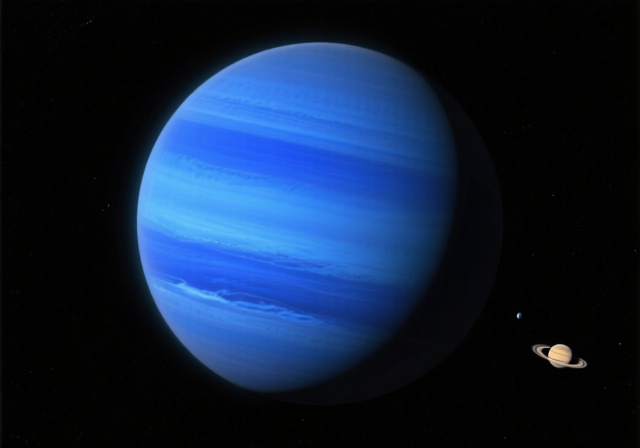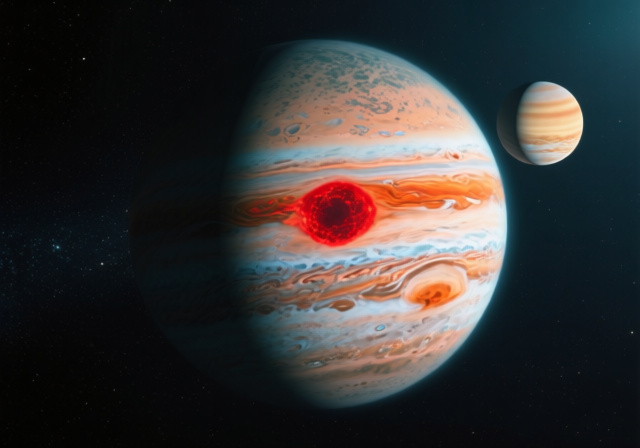

Have you ever wondered about the mysterious blue world at the edge of our solar system? Neptune, the eighth and most distant planet from the Sun, remains one of the most enigmatic and fascinating celestial bodies we know.
Neptune is the windiest planet in our solar system, with supersonic winds reaching speeds of up to 1,200 miles per hour, making it the most extreme weather world we’ve discovered.
As an ice giant shrouded in mystery and beauty, Neptune captivates scientists and space enthusiasts alike with its deep blue atmosphere, mathematical discovery story, and extreme weather phenomena that defy expectations.
In this comprehensive guide, I’ll share everything you need to know about this distant world, from its unique discovery through mathematics to its wild storms and mysterious moons that continue to surprise researchers.
Neptune’s discovery stands as one of the greatest triumphs of mathematical prediction in astronomy. Unlike other planets found through systematic observation, Neptune’s existence was calculated before anyone ever saw it through a telescope.
The story begins in the 1840s when astronomers noticed Uranus wasn’t following its predicted orbit. Something was tugging at it gravitationally. French mathematician Urbain Le Verrier spent months performing complex calculations to determine the position of this unknown body.
Independently, British mathematician John Couch Adams reached similar conclusions. Both men sent their predictions to observatories, but it was German astronomer Johann Gottfried Galle at the Berlin Observatory who first pointed a telescope at the calculated coordinates and found Neptune on September 23, 1846 – within one degree of Le Verrier’s prediction.
This mathematical achievement revolutionized astronomy and demonstrated that Newton’s laws of gravitation could accurately predict the existence of unseen worlds. It remains the only planet in our solar system discovered this way, earning it the nickname “the planet found with a pen.”
Neptune belongs to a class of planets called “ice giants,” along with its twin Uranus. These worlds are fundamentally different from the gas giants Jupiter and Saturn, containing more elements heavier than hydrogen and helium.
With a diameter of 49,528 kilometers (30,775 miles), Neptune is the fourth-largest planet in our solar system. You could fit 58 Earths inside Neptune, though it has only 17 times Earth’s mass due to its lower density.
The planet’s internal structure remains partially mysterious, but scientists believe Neptune has a small, rocky core about the size of Earth, surrounded by a layer of water, ammonia, and methane ices. Above this lies a thick atmosphere of hydrogen, helium, and methane extending thousands of kilometers into space.
One of Neptune’s most surprising features is its internal heat source. Despite being 30 times farther from the Sun than Earth, Neptune radiates more than twice as much energy as it receives from the Sun. This internal heat powers its extreme weather and helps explain why the planet has such dynamic atmospheric activity despite its distance from our star.
| Characteristic | Neptune | Earth |
|---|---|---|
| Diameter | 49,528 km (30,775 miles) | 12,742 km (7,918 miles) |
| Mass | 1.02 × 10^26 kg | 5.97 × 10^24 kg |
| Distance from Sun | 4.5 billion km (2.8 billion miles) | 150 million km (93 million miles) |
| Year Length | 165 Earth years | 365.25 days |
| Day Length | 16.1 Earth hours | 24 hours |
| Temperature | -200°C (-328°F) | 15°C (59°F) average |
| Known Moons | 16 | 1 |
Neptune’s atmosphere represents one of the most extreme weather systems in our solar system. This distant world experiences wind speeds that dwarf any hurricane on Earth, creating massive storm systems that rage across its deep blue surface.
The atmosphere consists primarily of hydrogen (74%), helium (25%), and methane (1%). It’s this small amount of methane that gives Neptune its distinctive blue color. Methane molecules absorb red light from sunlight and scatter blue light, similar to how Earth’s atmosphere makes our sky appear blue, though Neptune’s color is much more vivid.
Neptune’s winds are the fastest known anywhere in the solar system, reaching speeds up to 1,200 mph (1,950 km/h). For comparison, the strongest hurricanes on Earth barely exceed 200 mph (320 km/h). These incredible wind speeds create massive storm systems, including the famous Great Dark Spot observed by Voyager 2 in 1989.
The Great Dark Spot was an enormous anti-cyclonic storm larger than Earth, with winds measured at 300 mph (480 km/h). Surprisingly, when the Hubble Space Telescope observed Neptune five years later, the Great Dark Spot had vanished entirely. This demonstrated Neptune’s atmosphere is incredibly dynamic, with storm systems forming and dissipating over relatively short periods.
Recent observations from the Hubble Space Telescope have revealed that Neptune’s atmosphere continues to change. New storm systems have appeared and disappeared, and the planet’s overall cloud coverage seems to vary over time, suggesting a complex climate system we’re only beginning to understand.
Neptune’s moon system includes 16 known satellites, but one stands out above all others: Triton. This mysterious moon ranks among the most fascinating objects in our solar system due to its unique characteristics and unusual history.
Triton is Neptune’s largest moon by far, measuring 2,707 kilometers (1,680 miles) in diameter – larger than dwarf planet Pluto. It was discovered just 17 days after Neptune itself, found by British astronomer William Lassell in 1846.
What makes Triton truly remarkable is its retrograde orbit – it circles Neptune in the opposite direction of the planet’s rotation. This unusual orientation suggests Triton wasn’t born with Neptune but was likely a dwarf planet from the Kuiper Belt that Neptune captured billions of years ago. This capture event would have been catastrophic for any moons Neptune already had, explaining why Triton dominates the system so completely.
Triton’s surface is one of the coldest places in the solar system at -235°C (-391°F), yet it’s remarkably active. Voyager 2 discovered cryovolcanoes erupting nitrogen gas and dust up to 8 kilometers (5 miles) into space. These geysers create dark streaks across Triton’s surface, evidence of ongoing geological activity despite the extreme cold.
Beyond Triton, Neptune’s other moons are much smaller and less known. Nereid, discovered in 1949, has a highly eccentric orbit that takes it as far as 9.6 million kilometers (6 million miles) from Neptune. The remaining 14 moons were discovered by Voyager 2 or through Earth-based telescopes in recent years, and most are small, irregular bodies likely captured from the asteroid belt or Kuiper Belt.
Neptune also possesses a faint ring system, discovered only during Voyager 2’s 1989 flyby. The rings consist of five main components – Galle, Leverrier, Lassell, Arago, and Adams – composed primarily of ice particles with some dust contamination. Unlike Saturn’s prominent rings, Neptune’s are so dark and faint they weren’t visible from Earth until Voyager 2 passed by. The Adams ring contains several bright arcs named “Liberté, Égalité, and Fraternité,” whose unusual clumping remains a scientific mystery.
Human exploration of Neptune remains limited to a single extraordinary mission: Voyager 2. This spacecraft provided virtually all our detailed knowledge of Neptune and its moons during its historic 1989 flyby, making it one of the most successful space missions ever conducted.
Voyager 2 launched on August 20, 1977, as part of a grand tour of the outer solar system. The spacecraft visited Jupiter in 1979, Saturn in 1981, and Uranus in 1986, using gravity assists from each planet to propel itself toward Neptune. The journey to Neptune took 12 years, covering nearly 5 billion kilometers (3 billion miles).
When Voyager 2 arrived at Neptune on August 25, 1989, it became the first and only spacecraft to visit this distant world. The flyby was meticulously planned to take advantage of a rare planetary alignment that occurs only once every 175 years. This alignment allowed Voyager 2 to use Neptune’s gravity to redirect itself toward its encounter with Triton.
The mission’s discoveries were extraordinary. Voyager 2 revealed Neptune’s Great Dark Spot, measured the planet’s extreme winds, discovered six new moons, and provided the first detailed images of Triton’s surface and active geysers. The spacecraft also confirmed Neptune’s faint ring system and measured the planet’s magnetic field, finding it unusually tilted relative to the planet’s rotation axis.
Today, Voyager 2 continues its journey into interstellar space, but Neptune exploration continues through Earth-based telescopes and the Hubble Space Telescope. These ongoing observations have revealed that Neptune’s atmosphere continues to change, with new storm systems appearing and the Great Dark Spot’s disappearance confirming the dynamic nature of this distant world.
Scientists have proposed future missions to Neptune, including orbiters and atmospheric probes, but none have been funded yet. As we wait for the next spacecraft to visit this distant world, Neptune continues to guard many secrets, reminding us how much we still have to learn about our own solar system.
Observing Neptune from Earth presents a unique challenge for amateur astronomers. At nearly 30 times farther from the Sun than Earth, Neptune appears as a tiny blue dot even through large telescopes. However, with the right equipment and techniques, you can successfully observe this distant world.
First, you’ll need adequate astronomy observation equipment. While binoculars won’t show Neptune as anything more than a faint star, a telescope with at least 8 inches of aperture is recommended for serious observation attempts. Many amateur astronomers find success with telescopes in the 10-14 inch range.
The key to finding Neptune is knowing where and when to look. Neptune reaches opposition – when it’s closest to Earth and fully illuminated by the Sun – once each year. During opposition, Neptune rises at sunset and sets at sunrise, making it visible all night. The planet appears brightest during this time, though still quite dim at magnitude 7.7.
When looking for Neptune, use star charts or astronomy apps to locate its position relative to background stars. Neptune moves slowly against the star background, taking 165 years to complete one orbit, so its position changes only gradually from night to night.
Through a medium-sized telescope, Neptune will appear as a small blue disk rather than a point of light like a star. You might notice its distinctive blue color, though it will appear subtle rather than vivid. Seeing any detail on Neptune’s disk requires very large telescopes (16 inches or more) and excellent atmospheric conditions.
For the best results, consider investing in quality astronomy equipment. The best binoculars for planet viewing can help you locate Neptune’s general area, while a good telescope will reveal it as a disk. When choosing between equipment types, a reflector vs refractor telescope comparison can help you decide based on your budget and observing goals.
Don’t be discouraged if Neptune appears small or underwhelming at first. Remember you’re looking at a world 2.8 billion miles away – the fact that we can see it at all with backyard equipment is remarkable. Each observation connects you to one of the most distant worlds in our solar system.
Neptune was discovered mathematically, has the fastest winds in the solar system (1,200 mph), takes 165 Earth years to orbit the Sun, appears blue due to methane, has 16 moons including the retrograde-orbiting Triton, possesses faint rings, has only been visited by one spacecraft (Voyager 2), has an internal heat source, experienced the Great Dark Spot storm, and is classified as an ice giant planet.
Neptune is special because it’s the windiest planet in our solar system with supersonic winds, the only planet discovered through mathematical prediction rather than observation, has a large moon (Triton) that orbits backward, maintains extreme weather despite being far from the Sun, and remains the least explored major planet in our solar system.
Neptune orbits approximately 2.8 billion miles (4.5 billion kilometers) from the Sun, which is about 30 astronomical units (AU). At this extreme distance, sunlight takes 4 hours to travel from the Sun to Neptune, making it the most distant known planet in our solar system.
Neptune has 16 known moons. Triton is by far the largest, accounting for 99.5% of all mass orbiting Neptune. The other 15 moons are much smaller, with Nereid being the second-largest at only 340 kilometers in diameter. Most of Neptune’s smaller moons were discovered by Voyager 2 or through modern telescopes.
No, Neptune cannot be seen with the naked eye from Earth. At magnitude 7.7, Neptune is too faint to be visible without optical aid. You need at least binoculars to spot Neptune, and a telescope is recommended to see it as a small blue disk rather than just a point of light.
Only one spacecraft has ever visited Neptune: Voyager 2, which flew by the planet on August 25, 1989. Voyager 2 provided virtually all our detailed knowledge of Neptune, discovering its Great Dark Spot, measuring its extreme winds, and imaging Triton’s surface. No other spacecraft has visited Neptune since, though it continues to be observed by the Hubble Space Telescope.
Neptune remains one of the most intriguing worlds in our solar system, a distant blue giant that continues to surprise and challenge our understanding of planetary science. From its mathematical discovery to its extreme weather and mysterious moons, Neptune exemplifies how much we still have to learn about our cosmic neighborhood.
While only one spacecraft has visited Neptune, ongoing observations from Earth-based telescopes and the Hubble Space Telescope continue to reveal new aspects of this dynamic world. Each observation brings us closer to understanding not just Neptune itself, but the broader patterns of planetary formation and the diversity of worlds that exist in our universe.
Whether you’re an amateur astronomer hoping to glimpse this distant world through your telescope or simply someone fascinated by the wonders of our solar system, Neptune reminds us that discovery awaits at the edge of knowledge, waiting for those curious enough to look deeper into the cosmic mysteries that surround us.



